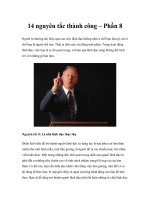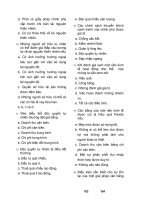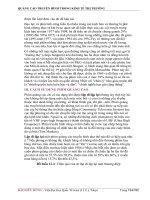Human Rights Indicators in Development phần 8 pptx
Bạn đang xem bản rút gọn của tài liệu. Xem và tải ngay bản đầy đủ của tài liệu tại đây (495.7 KB, 9 trang )
HumanRightsWP10.indd 54HumanRightsWP10.indd 54 10/7/10 10:19:11 AM10/7/10 10:19:11 AM
55
APPENDIX A
The Core International Instruments
and the Treaty Bodies
HumanRightsWP10.indd 55HumanRightsWP10.indd 55 10/7/10 10:19:11 AM10/7/10 10:19:11 AM
56
APPENDIX B
A Structure of
Human Rights Indicators
The Right to Food
Nutrition
Food Safety and
Consumer Protection
Food Availability
Structure
International
human rights
instruments,
relevant to the right
to adequate food,
ratified by the
states
Process
Proportion of pop.
below minimum
level of dietary
energy
consumption /
proportion of
undernourished
population
Outcome
Proportion of
under-weight
children belowage
five
Structure
International
human rights
instruments,
relevant to the right
to adequate food,
ratified by the
states
Process
The disposal rate/
average time to
adjudicate a case
registered in a
consumer court
Outcome
Number of
recorded deaths/
incidence of food
poisoning related to
adulterated food
Structure
International
human rights
instruments,
relevant to the right
to adequate food,
ratified by the
states
Process
Proportion of
female headed
households/ other
vulnerable groups
with legal title to
agriculture land
Outcome
Per capita
availability of major
food items of local
consumption
Food Accessibility
Structure
International
human rights
instruments,
relevant to the right
to adequate food,
ratified by the
states
Process
Share of household
consumption of
major food items
for vulnerable pop.
met through
publicly assisted
programmes
Outcome
Proportion of pop.
below minimum
level of dietary
energy
consumption/
proportion of
undernourished
pop.
.
Source: Fifth Inter-Committee Meeting of the Human Rights Treaty Bodies, 2006. Report on Indicators for
Monitoring Compliance with International Human Rights Instruments. HRI/MC/2006/7. May 11.
HumanRightsWP10.indd 56HumanRightsWP10.indd 56 10/7/10 10:19:12 AM10/7/10 10:19:12 AM
57
APPENDIX C
Human Rights Indicators Sources
The Cingranelli-Richards (CIRI) Human Rights Database
Purpose Assessing status of human rights violations of civil and political rights and women’s
rights
Use Designed for use by scholars and students to test theories about the causes and
consequences of human rights violations, as well as policy makers and analysts
who seek to estimate the human rights effects of a wide variety of institutional
changes and public policies.
Data sources U.S. State Department and Amnesty International country reports
Method of data
translation
Countries are rated according to the following variables on the basis of quantitative
assessment of numbers of violated cases:
Political or extrajudicial killings; unlawful or arbitrary deprivation of life
Disappearances
Torture
Political imprisonment
Freedom of speech and press
Freedom of religion
Freedom of movement
Freedom of assembly and association
Political participation
Worker rights
Women’s political rights
Woman’s economic rights
Woman’s social rights
Further information www.humanrightsdata.com
Political Terror Scale
Purpose Assessing (judgment of human rights conditions)
Use Used by scholars to examine the relationship between human rights and aid or
development
Data sources U.S. State Department and Amnesty International country reports
Method of data
translation
Rating of country reports on a 5-point scale, where 1 signifi es that the country is
under secure rule of law and 5 signifi es that there is a high level of violations of civil
and political rights in the country.
Further information />HumanRightsWP10.indd 57HumanRightsWP10.indd 57 10/7/10 10:19:12 AM10/7/10 10:19:12 AM
58 World Bank Study
The CEDAW Assessment Tool (American Bar Association (ABA) and Central European and
Eurasian Law Initiative (CEELI))
Purpose To assess the status of women as refl ected in a country’s laws and based on
the degree to which women in practice the rights and protections guaranteed by
CEDAW.
Use Intended to be a tool for aid organizations and governments to determine where
and how there is a need for intervention.
Data sources Laws of the state and interviews with a selection of at least 30 local people working
in the fi eld of women’s rights. Possible interviewees include human rights NGOs,
women’s rights NGOs, government offi cials and ministries, trade unions, media
representatives, law enforcement offi cials, judges, prosecutors, law professors, bar
association members, social workers, and individuals working at women’s health
clinics and reproductive health organizations.
Method of data
translation
Evaluation carried out by assessment team in corporation with local lawyers or
other local expert.
De jure analysis: national legislation is reviewed to determine the status of women
as refl ected in a country’s laws measured by CEDAW standards.
De facto analysis: to determine the actual realization of CEDAW in real life in the
country. Interviews with local experts to collect information on implementation of
laws and realization of rights from the viewpoint of those most involved in and
affected by a state’s compliance with CEDAW.
Conversion of data into a numerical scale of 5.
Further information .
Judicial Reform Index (American Bar Association (ABA) and Central European and Eurasian Law
Initiative (CEELI))
Purpose To assess the process of reforming the judiciaries in emerging democracies
Use Enable ABA and CEELI, its funders, and the emerging democracies themselves
to better target judicial reform programs and monitor progress toward establishing
more accountable, effective, and independent judiciaries.
Data sources Based on interviews with key informants and on relevant available data.
Method of data
translation
Assessors are given a series of 30 statements setting forth factors that indicate
the development of an accountable, effective, and independent judiciary. The
categories incorporated address the quality, education, and diversity of judges;
jurisdiction and judicial powers; fi nancial and structural safeguards; accountability
and transparency; and issues affecting the effi ciency of the judiciary. Each
statement is allocated one of three values: positive, neutral, or negative. When the
statement strongly corresponds to the reality in a given country, the country is to be
given a score of positive for that statement. However, if the statement is not at all
representative of the conditions in that country, it is given a negative.
The 30 statements are based on both subjective and objective criteria and on
criteria examined on some fundamental international norms, such as those set out
in the U.N. Basic Principles on the Independence of the Judiciary.
Further information
HumanRightsWP10.indd 58HumanRightsWP10.indd 58 10/7/10 10:19:13 AM10/7/10 10:19:13 AM
Human Rights Indicators in Development 59
Freedom in the World: Freedom House
Purpose To assess the degree of freedom in 193 countries and 58 territories in the world as
part of Freedom House’s “work to advance the worldwide expansion of political and
economic freedom.”
Use Tool to assess state of political rights and civil liberties in the countries of the world.
Data sources A broad range of sources of information is used in preparing their reports, including
foreign and domestic news reports, academic analyses, nongovernmental
organizations, think tanks, individual professional contacts, and visits to the region.
World Population Data Sheet of the Population Reference Bureau. The World
Almanac and Book of Facts, the CIA World Factbook, the BBC, World Gazetteer,
the Unrepresented Nations and Peoples Organization (UNPO) and World Bank’s
World Development Indicators.
Method of data
translation
Rating of countries on a 7-point scale:
The ratings process is based on a checklist of 10 political rights questions and
15 civil liberties questions. Raw points are awarded to each of these questions on
a scale of 0 to 4, where 0 points represents the smallest degree and 4 points the
greatest degree of rights or liberties present. The highest number of points that can
be awarded to the political rights checklist is 40 (or a total of up to 4 points for each
of the 10 questions). The highest number of points that can be awarded to the civil
liberties checklist is 60 (or a total of up to 4 points for each of the 15 questions).
The total number of points awarded to the political rights and civil liberties
checklists determines the political rights and civil liberties ratings. Each point total
corresponds to a rating of 1 through 7, with 1 representing the highest and 7 the
lowest level of freedom.
Further information
HumanRightsWP10.indd 59HumanRightsWP10.indd 59 10/7/10 10:19:13 AM10/7/10 10:19:13 AM
60
APPENDIX D
Defi nition of Right to Water
Right to water and sanitation
Legal standards The Right to Water is primarily a part of CESCR article 11.1— Right to a Decent
Standard of Living— because the Covenant text “including adequate food, clothing and
housing” is not intended to be exhaustive.
The right to water is also part of the following:
The right to health (CESCR article 12— see GC 14, para 11– 12)
The right to housing and food (CESCR article 11.1— see GC 4, para 8(b))
The right to life and human dignity (UDHR article 3; CCPR article 6— see GC 15, para 3).
The right to primary health care (CRC article 24)
The right to freedom from discrimination against women in rural areas (CEDAW article
14.2).
Core content
according to the
Committee on
ESCR
The right to water is dealt with in General Comment 15 in which the core content is
defi ned as (GC15, para 37):
“To ensure access to the minimum essential amount of water, that is suffi cient and
safe for personal and domestic uses to prevent diseases;
To ensure the right of access to water and water facilities and services on a non-
discriminatory basis, especially for disadvantaged or marginalized groups;
To ensure physical access to water facilities or services that provide suffi cient, safe
and regular water; that have a suffi cient number of water outlets to avoid prohibitive
waiting times; and that are at a reasonable distance from the household;
To ensure personal security is not threatened when having to physically access to
water;
To ensure equitable distribution of all available water facilities and services;
To adopt and implement a national strategy and plan of action addressing the whole
population [ . . . ]
To monitor the extent of the realization, or the non-realization, of the right to water;
To adopt relatively low-cost targeted water programmes to protect vulnerable and
marginalized groups;
To take measures to prevent, treat and control diseases linked to water, in particular
ensuring access to adequate sanitation;”
“Priority in the allocation of water must be given to the right to water for personal and
domestic uses. Priority should also be given to the water resources required to prevent
starvation and disease, as well as water required to meet the core obligations of each
of the Covenant rights” (GC 15, para 6)
The right to water must be adequate for human dignity, life and health (GC 15,
para 11). The following factors always apply to adequacy: availability, quality and
accessibility (physical, economic, non-discrimination and information accessibility) (GC
15, para 12).
HumanRightsWP10.indd 60HumanRightsWP10.indd 60 10/7/10 10:19:13 AM10/7/10 10:19:13 AM
Human Rights Indicators in Development 61
GC 14 on the Right to Health says that a dimension of the right relates to quality,
including the need for “safe and potable water, and adequate sanitation” (GC 14, para
12d). The core content of the right to health further includes an obligation “to ensure
access to basic shelter, housing and sanitation, and an adequate supply of safe and
potable water” (GC 14, 43(c)).
Approaches of
scholars
“There is an urgent need for the international community to meet its commitment to the
water sector and to begin addressing the world’s water problems with renewed vigour.
The RBA [rights-based approach] is a tool for emphasising government obligations
and for drawing the world’s attention to the state of water resources and management
encourages this. It also provides a valuable approach to the implementation and
management of water services. Experience documented by development practitioners
shows that the RBA improves the overall accessibility, effi ciency and sustainability
of water-related development projects.” Emilie Filmer-Wilson, 2005. The Human
Rights-Based Approach to Development. The Right to Water. Netherlands Quarterly of
Human Rights, Vol. 23, 2, p. 240.
HumanRightsWP10.indd 61HumanRightsWP10.indd 61 10/7/10 10:19:13 AM10/7/10 10:19:13 AM
62
APPENDIX E
Defi nition of the Right to Education
The Right to Education
Legal standards The UDHR article 26: “Everyone has the right to education. Education shall be free,
at least in the elementary and fundamental stages. Elementary education shall be
compulsory [. . .]”
The CESCR, article 13 and 14 clearly acknowledge “the right of everyone to
education” and the obligation to provide primary education “compulsory and available
free to all”— or to at least fi x a detailed national strategy that ensures that such
education is progressively implemented “within a reasonable number of years.”
The UNESCO Convention Against Discrimination in Education also affi rms the right to
education, including the right to free and compulsory primary education that must be
provided on a nondiscriminatory basis.
References to the right to education are also included in the following:
CEDAW, article 10 and 16.
CRC article 28 and 29.
The International Convention on the Protection of the Rights of All Migrant Workers
and the Members of their Families article 12, 30, 43, and 45.
Core content
according to the
Committee on
ESCR
The right to education is dealt with in General Comments 11 and 13.
The right to education is framed according to “the four A’s” (GC 13, para 6):
Availability: the quantity of institutions and programs. It also concerns the requirements
in terms of buildings, sanitation, trained teacher, etc., which are all context-dependent.
Accessibility: has three dimensions: (1) Nondiscrimination; (2) Physical accessibility;
and (3) Economic accessibility, underlining the need for education to be affordable to
all and, at least, primary education to be free.
Acceptability: cultural adequacy and the acceptability of the form, substance, and
methods of the education to students (and parents). Minimum educational standards
may be approved by the state.
Adaptability: the education must adapt to the particular needs of the communities and
the students.
The core content includes an obligation for the state on the following fi ve points
(GC13, para 57):
“Ensure the right of access to public educational institutions and programmes on a
non-discriminatory basis.”
“Ensure that education conforms to the objectives set out in article 13(1).”
“Provide primary education for all in accordance with article 13(2)(a),” i.e., ensure free
and compulsory universal primary education that guarantees to satisfy all children’s
basic learning needs and are cultural and locally adequate.
“Adopt and implement a national educational strategy which includes provision for
secondary, higher and fundamental education.”
HumanRightsWP10.indd 62HumanRightsWP10.indd 62 10/7/10 10:19:13 AM10/7/10 10:19:13 AM









